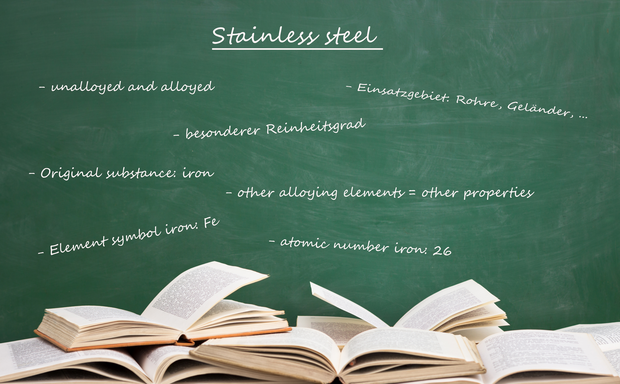Stainless steel is a term for unalloyed and alloyed steels that have a particular degree of purity.
The degree of purity is an indication of the content of inclusions in the material. The original substance or
material from which stainless steel is obtained is iron. Iron has the atomic number 26 and the element symbol Fe,
which means "ferrum" in Latin. It has a greyish sheen and is used in tools or structures such as the Eiffel Tower.
It is mainly used for steel production. It is often claimed that stainless steel does not rust. However, this claim is false.
Stainless steel usually only refers to the purity of the material. Other factors are relevant for a stainless steel.
Properties of stainless steel
Stainless steel is extremely corrosion and temperature resistant, but also conductive.
Depending on the alloying elements, the properties change. The most common alloying components are chromium,
molybdenum, titanium and the combination of chromium and nickel. With the alloying element chromium (Cr),
the steel becomes hard, heat-, rust- and chemical-resistant. If nickel is used as an alloying element in addition to chromium,
the steel acquires further properties. These include good weldability, hardness, acid and rust resistance.
The combination of the two alloying elements ensures good machining in welding work. The combination increases hardness and
resistance to acids and rust. The alloying element molybdenum (Mo) provides heat resistance and a strong, rust-resistant, elastic steel.
Since, as mentioned above, the original material of stainless steel is iron,
it must first be extracted. So iron ore and coke are put into a blast furnace where hot air is blown in. Iron and carbon dioxide are produced from a chemical reaction that removes the oxygen from the ore. The iron melts in the blast furnace and a slag forms on top, which is separated from the molten pig iron. In the next step, the Frisch reaction, oxygen is blown into pig iron, forming liquid iron oxide. Other substances that are not needed are removed from the iron oxide. In the deoxidation reaction, oxygen is removed from the steel with the help of aluminium. In the subsequent desulphurisation reactions, the sulphur in the pig iron is converted to sulphide. Finally comes the degassing reactions, in which crude steel is degassed to remove hydrogen and carbon monoxide. Alloying then transforms the resulting steel into the desired material: stainless steel. During steel production, steel refiners such as titanium or chromium are added. Stainless steel is used, for example, in mechanical engineering, vehicle manufacturing or architecture. Other examples of the use of stainless steel are: Pipes, cutlery or railings.
Do you want to have a milled or turned part made from a hard metal such as stainless steel?
Or are you interested in having your desired component milled, turned or drilled with the help of contract manufacturing?
Submit your enquiry quickly and easily and we will get back to you with a quote in line with the market.
We look forward to hearing from you.


